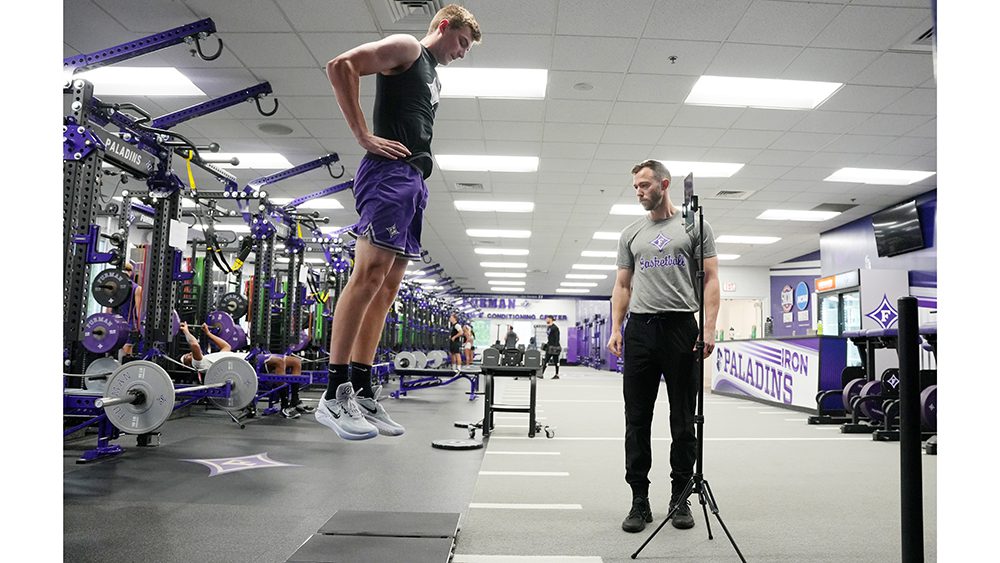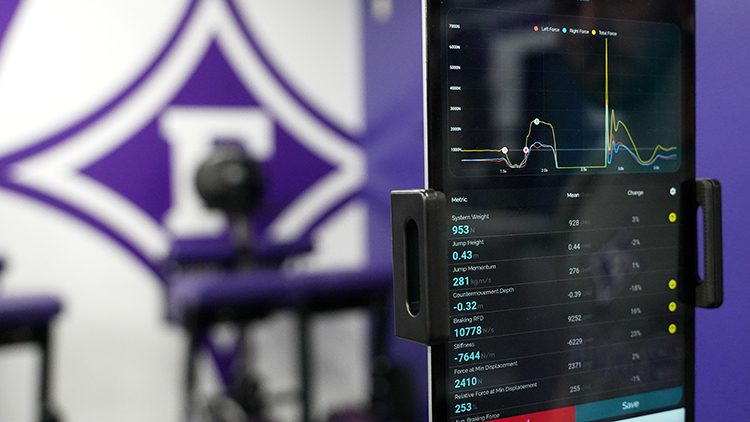Furman research helps elevate Paladin Men’s Basketball

If it looked like the Furman University men’s basketball team jumped higher, ran faster and played stronger as this past season progressed, they did. In fact, thanks to research conducted the season before, the team’s physical performance was still improving when they beat the University of Virginia in the NCAA Tournament.
During the 2021-2022 season, Matt Aldred, assistant strength and conditioning coach for the Paladins men’s team, tracked the progress of nine players who played in every game twice a week over an 18-week period, starting before the season and finishing the week of the 2022 Southern Conference Tournament. Aldred worked on the project with Scott Murr ’84, associate professor of health sciences, and athletic trainer Justin Games; their results were published in The American Journal of Sports Science.
To measure performance, Aldred used force plates, highly sophisticated equipment that looks like a pair of over-sized digital bathroom scales. He had the players perform a countermovement jump; a player steps on the plates with hands on his hips and jumps as high as possible, then lands back on the plates. The force plates determine the jump height and other metrics to gauge lower-body power and neuromuscular readiness, which reflect how fresh or fatigued a body is.

A tablet displays the information collected from force plates that are being used by the men’s basketball team during workouts.
Previous research into the impact of a competitive sports season on player fatigue and readiness has been inconclusive. The Furman research, Murr said, is probably the first to specifically measure and monitor the jump performance of a basketball team from the beginning of a season through the end. Season-long studies in other sports have measured other factors and showed a decline in physical performance.
But the Paladin men either maintained or improved their physical performance in the metrics being analyzed. Their jump height continued to rise into March. That’s a great sign that the players not only stayed healthy but were getting stronger while juggling the stresses of being full-time students, traveling to away games, practicing, playing two games a week and dealing with normal life events.
“It shows that we got the players to peak performance when they needed to peak,” for the conference tournament, Aldred said, balancing practice and weightlifting with other aspects of physical preparation, like rest, nutrition, sleep and psychology. The data from the 2021-2022 season informed this past season, when players again continued to improve throughout conference play and into the NCAA Tournament, when the team set a record for games won.
Murr said the job of pushing players to get stronger without stressing them too much is “quite a jigsaw puzzle. (Head Men’s Basketball) Coach Bob Richey and Matt have really done an amazing job,” adapting to players’ needs and adopting technology that provides scientific feedback.
Players responded not only to data-driven training, but to the data itself. Aldred shares with them their results, which show continual progress and personal bests. “The confidence they get from that going into the season is super beneficial to them,” he said.
The force plates, which Furman has used for three seasons, give the team an advantage over schools that haven’t adopted the technology yet. They help bridge the competitive divide between larger schools that have even more resources, and they can help players develop over the course of their time playing for the Paladins.
“We want to see young players developing slowly, and seniors not getting fatigued,” Murr said. Jalen Slawson and Mike Bothwell, stars of last season, didn’t miss a single game due to injury during their five years at Furman, thanks in part to data-driven training plans.
Another competitive advantage the Paladins have over other universities, Murr and Aldred said, is the collaboration among themselves and Games. It’s unusual at universities to have Division I athletic staff, like Aldred and Games, working closely with a faculty member, like Murr. Their work together could also help advance sports science, as the force plate study is likely the first of many more to come.